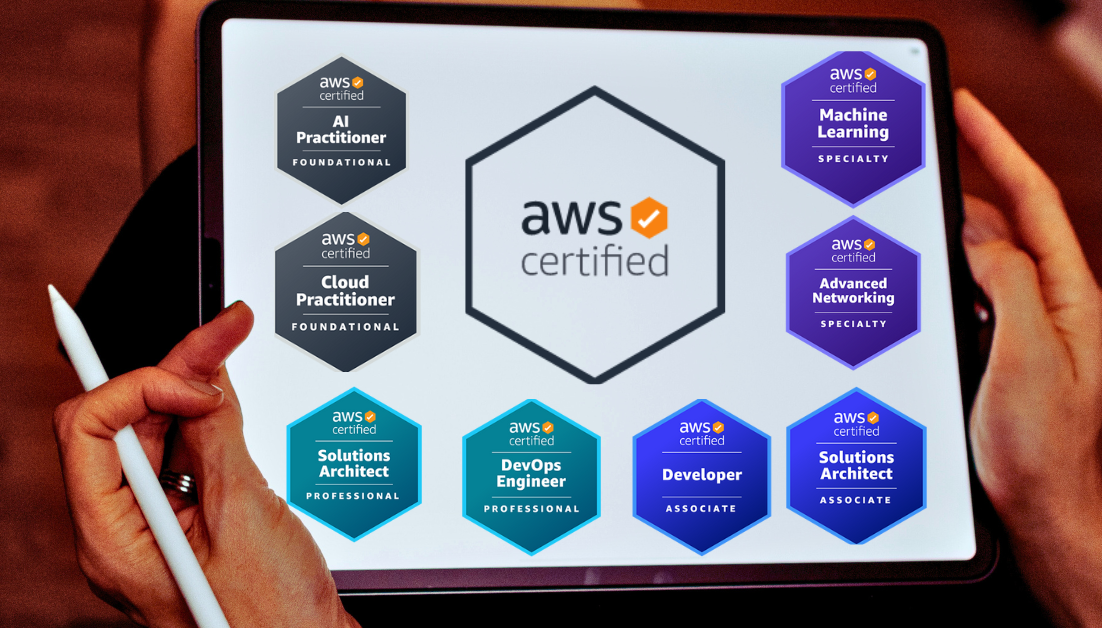How to Pick the Right Online Learning Platform for STEM Courses

Are you looking for your next online course in Science, Technology, Engineering, or Mathematics (STEM)? With hundreds of platforms available, each promising to turn you into a pro, deciding where to start can be overwhelming. And let’s face it: there’s nothing more frustrating than investing time and money in a STEM course only to discover halfway through that the platform doesn’t live up to its promise.
Whether you’re a beginner exploring coding basics or an advanced learner diving into calculus, choosing the right online learning platform is essential for a smooth and effective learning experience. This guide offers practical tips to help you find the perfect platform for STEM courses and maximize your learning journey.
Begin by Planning Your Learning Journey
If you’ve signed up for multiple courses but rarely finish them, you’re not alone. Studies show that only around 13% of students complete online courses. Without a clear plan, it’s easy to lose motivation or feel overwhelmed.
Here’s how to map out your STEM learning goals effectively:
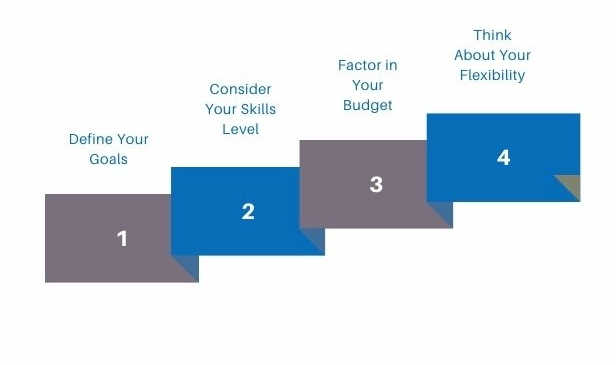
Define Your Learning Goals
Are you preparing for an exam or building a professional skill set? For short-term goals like passing a test, choose platforms offering topic-specific lessons, quizzes, and feedback.
For example, Khan Academy provides free exam practice tests for Math SATs and Biological Sciences MCATs.
For career development, opt for platforms like Udemy, which offer hands-on training and certificates to showcase your skills.
Consider your Level of Studies
Not all platforms cater to the same skill level. For example, Khan Academy mainly offers STEM subjects for high school students while Coursera and edX partner with universities and corporate organizations to train professionals.
Factor in Your Budget
Decide how much you can invest and whether earning a recognized certificate is worth the extra cost. Some platforms, like Codecademy and Khan Academy, provide free content, while others, like Udacity, combine free introductory lessons with premium options for advanced learners.
Think About Your Flexibility
Choose a flexible self-paced course if you have limited time. However, if you thrive under structure and deadlines, courses with timetables can keep you disciplined and on track.
If you have limited time, choose self-paced courses. However, structured courses with deadlines, like those on Coursera, might suit you if you thrive under discipline.
Now that you’ve mapped out your plan, let’s discuss some practical tips to help you choose the right platform for your STEM course.
Assess the Course Content and Curriculum Quality
A well-structured, up-to-date curriculum is crucial for STEM fields, where advancements occur rapidly. Follow these steps to evaluate a platform’s curriculum:
Examine Instructor Credentials
Research the background of the course instructors. Are they industry experts or respected academics with proven experience in their fields? A course led by a software engineer for a top tech company or a professor with a track record of research publications will likely offer a richer, more insightful learning experience.
Here’s a sneak peek of some of Coursera’s expert instructors to give you an idea of what to look out for:
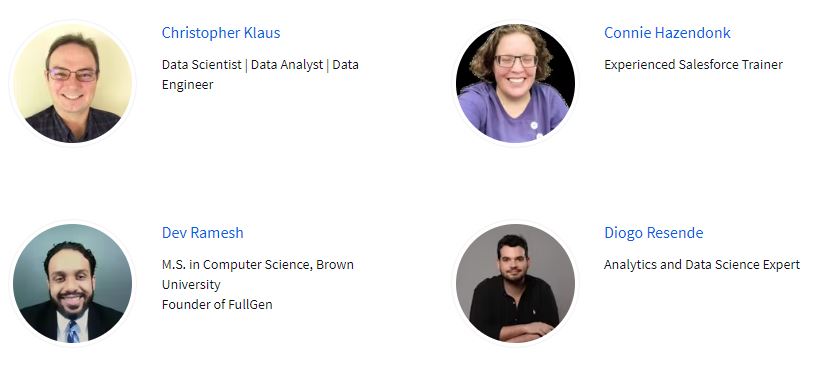
Look for Partnerships with Renowned Institutions
Platforms that collaborate with leading universities or global corporations often deliver higher-quality content. These partnerships indicate that the curriculum has been vetted and meets real-world demands and academic standards, giving you a competitive edge in your learning.
For example, edX partners with prestigious universities like MIT and Harvard and also collaborates with tech giants like Google and Amazon to deliver high-quality STEM courses.
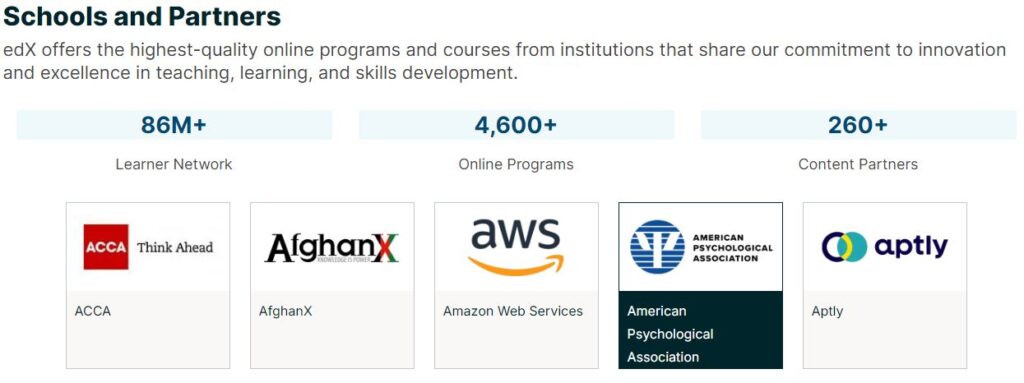
Check for Regular Updates
STEM fields are dynamic, with new developments occurring frequently. See if the platform notes when the content was last updated. Curricula that include recent case studies, emerging technologies, and current best practices will keep you ahead of the curve.
For instance, CodeAcademy has a dedicated page that updates its users on recent and ongoing content revisions for its Web Development content.
Assess the Depth of the Course Offerings
Does the platform provide just a few introductory classes, or does it have a comprehensive range of courses, from beginner to advanced levels? A broad and deep catalog often reflects a well-thought-out curriculum structure that can cater to evolving learning needs as you progress.
For example, Udacity offers free introductory courses for a wide range of topics and gives learners who want to advance their knowledge the option to join its Nanodegree programs.
Evaluate the Platform’s User Experience
Ever tried navigating a cluttered website or struggled to find a course module you needed? When it comes to online learning, user experience can significantly impact your progress and motivation. A well-designed, user-friendly interface keeps you engaged and makes learning seamless.
Look for platforms with:
Interactive Dashboards
An organized dashboard that displays your overall performance, completed modules, and upcoming lessons helps you stay on course in your learning journey.
In addition, look for:
- Easy navigation tools such an intuitive menu with a visible search bar that make it easy to find specific content or revisit previous lessons.
- Engaging features like interactive simulations, virtual labs, live Q&A sessions, or community forums that transform passive learning into active exploration.
Check out Udacity’s interactive dashboard that provides a visual progress bar, AI-powered course recommendations, and an easy navigation bar to keep its learners engaged.
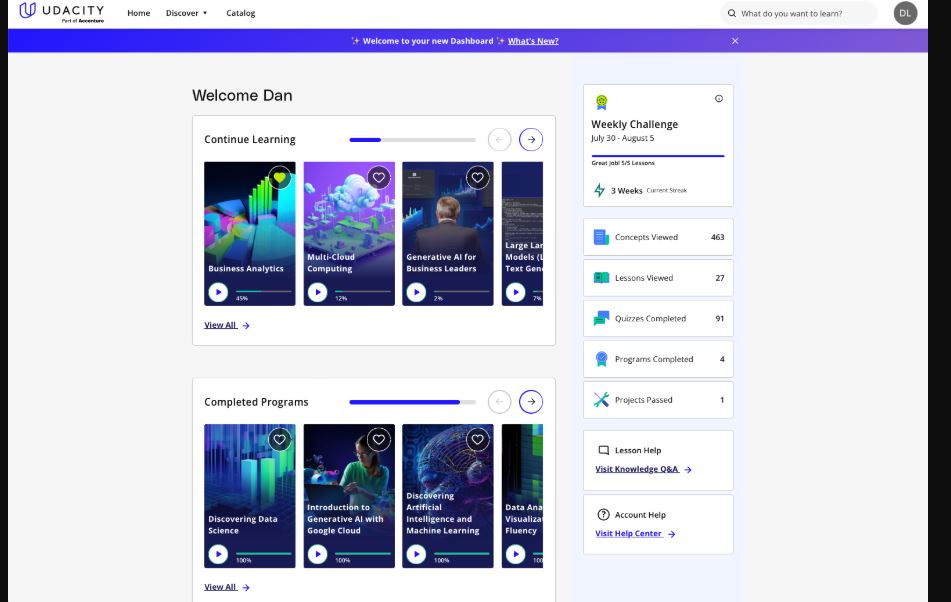
Immediate Feedback
Platforms that offer instant feedback on module quiz assessments ensure you absorb what you learn.
We love how Codecademy uses a built-in editor and AI tools to explain concepts, give live feedback, and helpful tips to help learners pass coding exercises.
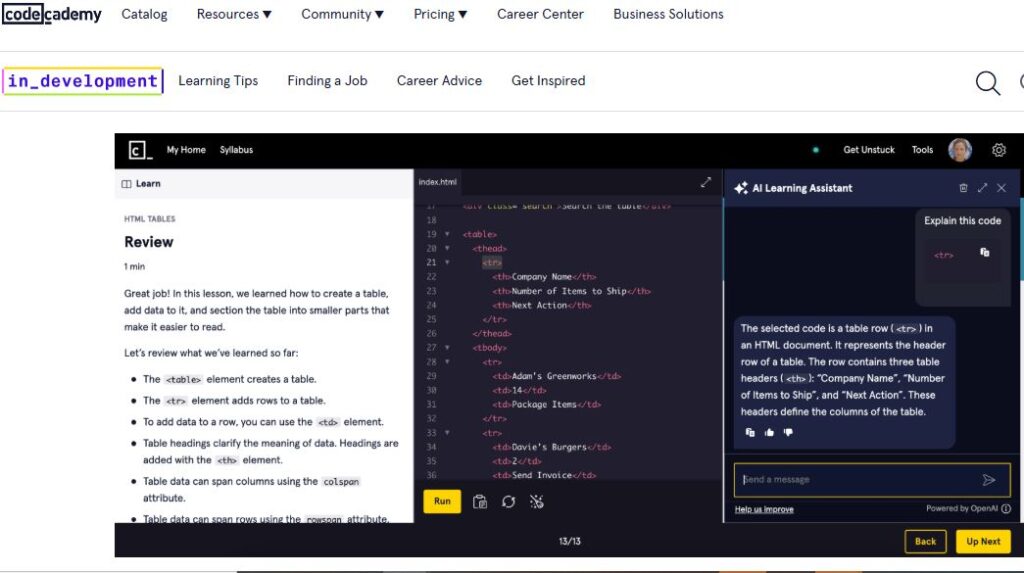
Mobile Compatibility
Learning on the go is a major benefit of online courses. Check if the course providers have a fully optimized mobile app to ensure you can access lessons wherever you are.
Find a Platform That Lets You Practice As You Learn
STEM learning is most effective when theory is combined with practice. Hands-on learning helps solidify complex concepts, build confidence, and prepare you for real-world challenges. After all, what good is learning a new programming language if you can’t use it to build a functional app, or mastering physics if you can’t solve practical problems?
To make the most of your STEM journey, choose platforms that offer hands-on training with features such as:
Sandboxes and Labs
Sandboxes and virtual labs give you a safe space to experiment without real-world consequences. Whether you’re coding, building models, or working with data, these environments let you test your knowledge, troubleshoot errors, and learn by doing in real time.
For example, Pluralsight has several cloud labs for AWS and Azure that enable learners to set up, configure, and deploy cloud services.
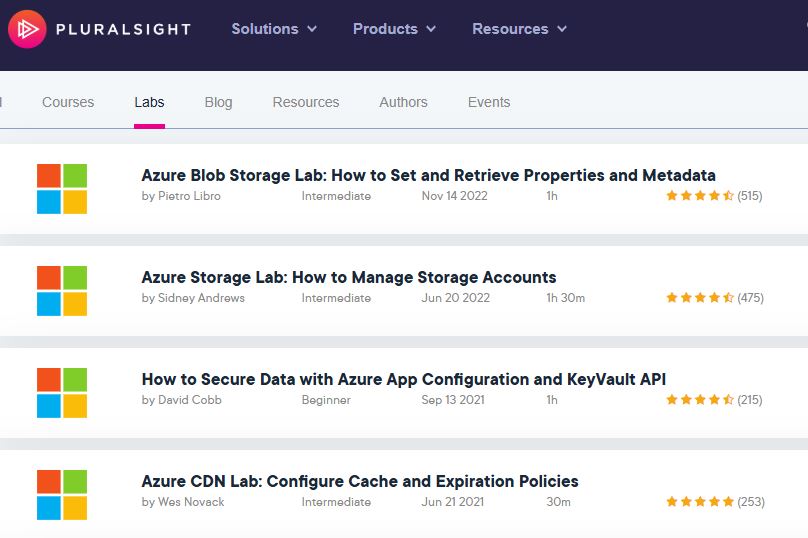
Simulations
Want to test chemical reactions, tweak an engineering design, or solve complex system behavior? Interactive simulations are invaluable for subjects like engineering or biology enabling you to explore without needing physical equipment.
Some popular learning platforms that offer interactive simulations for STEM students to experiment include;
| Name | Subjects Covered |
| PhET by University of Colorado, Boulder | Physics, Math and Statistics, Chemistry, Earth and Space, Biology |
| LabXchange by Harvard University | Physics, Biology, Chemistry, Earth and Space |
| Molecular Workbench by The Concord Consortium | Physics, Chemistry, Biology, Biotechnology, Nanotechnology |
Live Coding Workshops
Some platforms host live coding sessions or interactive workshops where you can collaborate with instructors and peers in real-time. This type of engagement makes learning more dynamic and encourages immediate feedback, helping you troubleshoot issues on the spot and learn from the mistakes of others, too.
For example, Codecademy organizes regular Livestreams where instructors walk learners through coding challenges, explaining their thought processes and answering questions.
Find Courses with Strong Community Support Networks
A strong STEM community gives you the encouragement and practical support needed to stay motivated and excel in your courses. In addition, engaging with a network of peers, mentors, and industry professionals provides invaluable opportunities for collaboration, feedback, and even job prospects.
Here are some ways to find and benefit from community support when choosing an online STEM course:
Social Media Community Forums
Many platforms host active public forums or have dedicated social media groups where learners connect, exchange ideas, ask questions, and share progress.
For example, edX has an informative reddit community for students and educators. You can also join public socials such as Discord and Slack channels to broaden your support network.
Small Private Support Groups
Connecting with learners in the same stage of your journey fosters a sense of teamwork. Look for platforms that allow or encourage students to form smaller study groups or have support tools such as buddy matching.
For example, Udacity has a dedicated Learners Community where students can connect with peers and participate in exclusive events.
Codecademy also runs community-led local groups called Chapters where students organize virtual meet-ups, hackathons, and project brainstorms.
Mentorship Opportunities
A great community often goes beyond just peer interaction. Look for platforms that offer access to mentors—experienced professionals or instructors who can guide you through challenges, offer personalized advice, and share industry insights.
For example, Udacity’s mentorship network brings together experts from leading companies like Google and Microsoft who guide students as career coaches, session leads, project reviewers, and tutors.
Networking Events and Job Boards
Some platforms have dedicated spaces for networking, virtual events, or even job boards for graduates. These connections can lead to job opportunities, internships, or professional collaborations.
For instance, platforms like Codecademy have career path programs that help IT learners get job-ready by connecting them with employed alumni, preparing them for technical interviews, and advising them with actionable portfolio-building tips.
Read Reviews and Seek Recommendations
Unbiased reviews offer insights into everything, including the content quality, instructors’ teaching style, platform’s usability, and overall value of the STEM course.
When reading reviews, look out for red flags such as:
- Overly positive or generic reviews without specific course details may be a sign of incentivized or overly moderated reviews to boost the platform’s reputation.
- Recurring students’ complaints about the same issue, such as outdated content, lack of instructor support, or poor usability may signal genuine flaws.
- Reviews questioning the validity or recognition of certificates awarded upon completion which may have limited value in your career progression.
You can scout for reliable reviews from:
Trustworthy Review Sites
Websites like Trustpilot, Reddit, or dedicated e-learning review sites often contain more balanced and diverse opinions. These independent platforms are less likely to filter feedback, giving you a more accurate picture of the strengths and weaknesses of a course.
Social Media and Online Forums
Social media groups and forums related to specific STEM fields often feature posts where learners share their experiences. Educational communities like Meetup groups or Slack channels dedicated to your area of interest can also provide genuine feedback.
Professional Networks
Ask your colleagues, classmates, or mentors in your field for recommendations based on personal experiences.
Platform Review Pages
Many course platforms host reviews on their own websites. While these can provide valuable insights, take them with a grain of salt, as some platforms may highlight only the most glowing testimonials. Still, scanning through reviews can help spot recurring praises or common complaints.
If Possible, Test Before Committing
Platforms like Coursera, Udacity, and Pluralsight often offer free trials or samplers that can give you a sense of what to expect before fully diving into the STEM course.
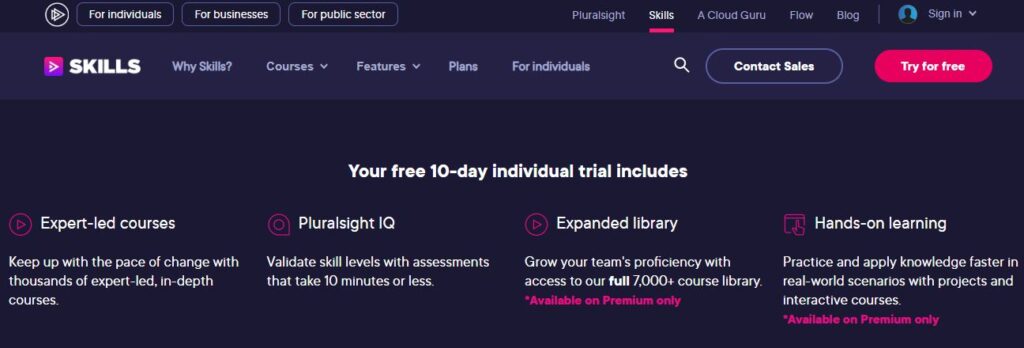
During your trial, use the opportunity to:
- Gauge the teaching style, course format, and depth of the content
- Explore the platform features and tools that support the course material
- Consider if the content matches your learning goals, expectations, and skill level
Be mindful of trial limitations, such as restricted access to assignments, locked features, or time constraints. Make sure you understand what’s included in the trial period so you can evaluate it accurately without surprises.
Explore More STEM Opportunities at STEMpowerUp
Choosing the right online learning platform is a crucial step in achieving your STEM goals. By following the tips in this guide, you’ll be better equipped to select a course that aligns with your aspirations, level, and budget.
Are you looking for more valuable STEM resources? We regularly update our blog with the latest courses, apprenticeships, scholarships, and upcoming events to empower students to thrive in their STEM journey. Sign up for our newsletter to stay updated on trending STEM opportunities.
